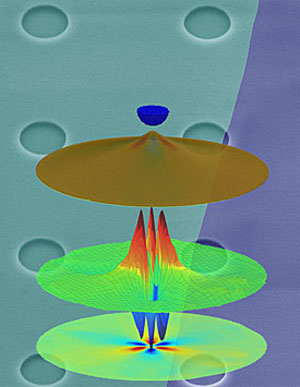| Jul 12, 2012 |
'Tuning' graphene drums might turn conductors to semiconductors
|
|
(Nanowerk News) Tightening or relaxing the tension on a drumhead will change the way the drum sounds. The same goes for drumheads made from graphene, only instead of changing the sound, stretching graphene dramatically alters the material's electrical properties. Researchers working at the National Institute of Standards and Technology (NIST) and the University of Maryland have shown* that subjecting graphene to mechanical strain can mimic the effects of magnetic fields and create a quantum dot, an exotic type of semiconductor with a wide range of potential uses in electronic devices (see paper in Science: "Electromechanical Properties of Graphene Drumheads").
|
 |
| NIST researchers showed that straining graphene membrane creates pseudomagnetic fields that confines the graphene's electrons and creates quantized quantum dot-like energy levels. The background is a false color image of the graphene drumheads made from a single layer of graphene over 1 micron-sized pits etched in a silicon dioxide substrate. (Image: N. Klimov and T. Li, NIST/UMD)
|
|
Graphene is a single layer of carbon atoms arranged in a honeycomb lattice. Pure graphene is a phenomenal conductor, transmitting electricity with little resistance at room temperature. But microelectronic devices depend on semiconductors that can be turned "on" and "off" because they have an energetic threshold beneath which they won't conduct electricity. This new work demonstrates that mechanical strain can be used to make tiny regions of graphite act like a classic semiconductor.
|
|
The research team suspended a sheet of graphene over shallow holes in a substrate of silicon dioxide—essentially making a set of graphene drumheads. In probing the drumheads with a scanning probe microscope, they found that the graphene rose up to meet the tip of the microscope— a result of the van der Waals force, a weak electrical force that creates attraction between objects that are very close to each other. Calculations by the University of Maryland group showed that the graphene should stretch into a peak, like the top of a circus tent.
|
|
The researchers discovered that they could tune the strain in the drumhead using the conducting plate upon which the graphene and substrate were mounted to create a countervailing attraction and pull the drumhead down. In this way, they could pull the graphene into or out of the hole below it.
|
|
Their measurements showed that changing the degree of strain changed the material's electrical properties. When they pulled the graphene membrane into the tent-like shape, the region at the apex acted just like a quantum dot, a type of semiconductor in which electrons are confined to a small region of space.
|
|
"Normally, to make a graphene quantum dot, you would have to cut out a nanosize piece of graphene," says NIST fellow Joseph Stroscio. "Our work shows that you can achieve the same thing with strain-induced pseudomagnetic fields. It's a great result, and a significant step toward developing future graphene-based devices."
|
|
More details are available in this previous news item: Graphene drumheads tuned to make quantum dots
|
|
For further information on any of these standards or to buy a copy, visit shop.bsigroup.com
|

